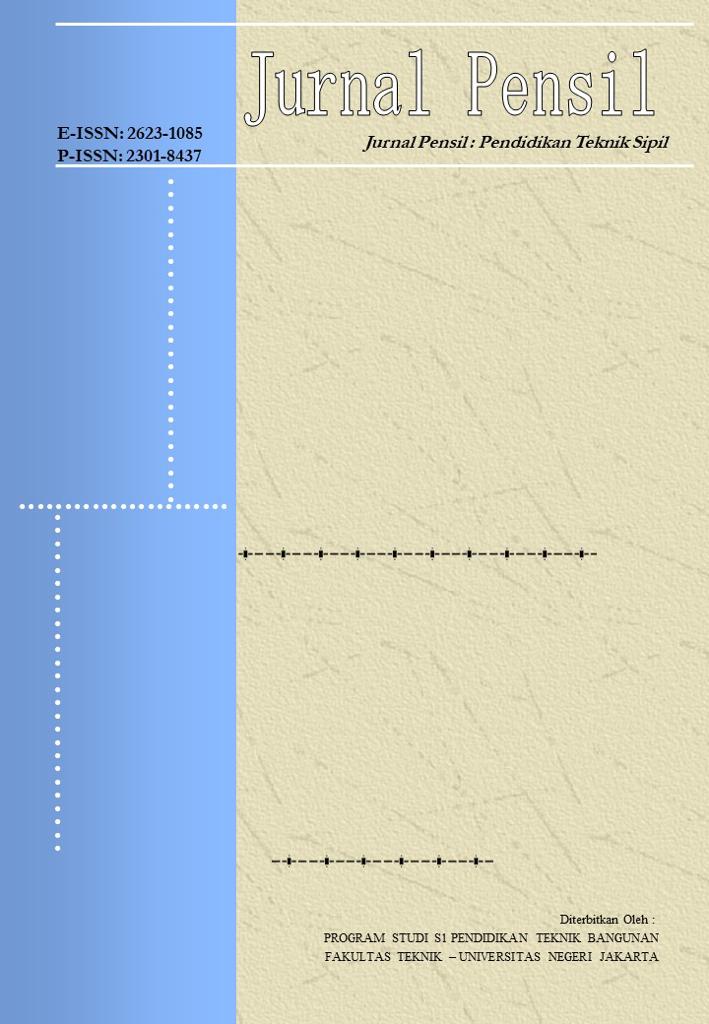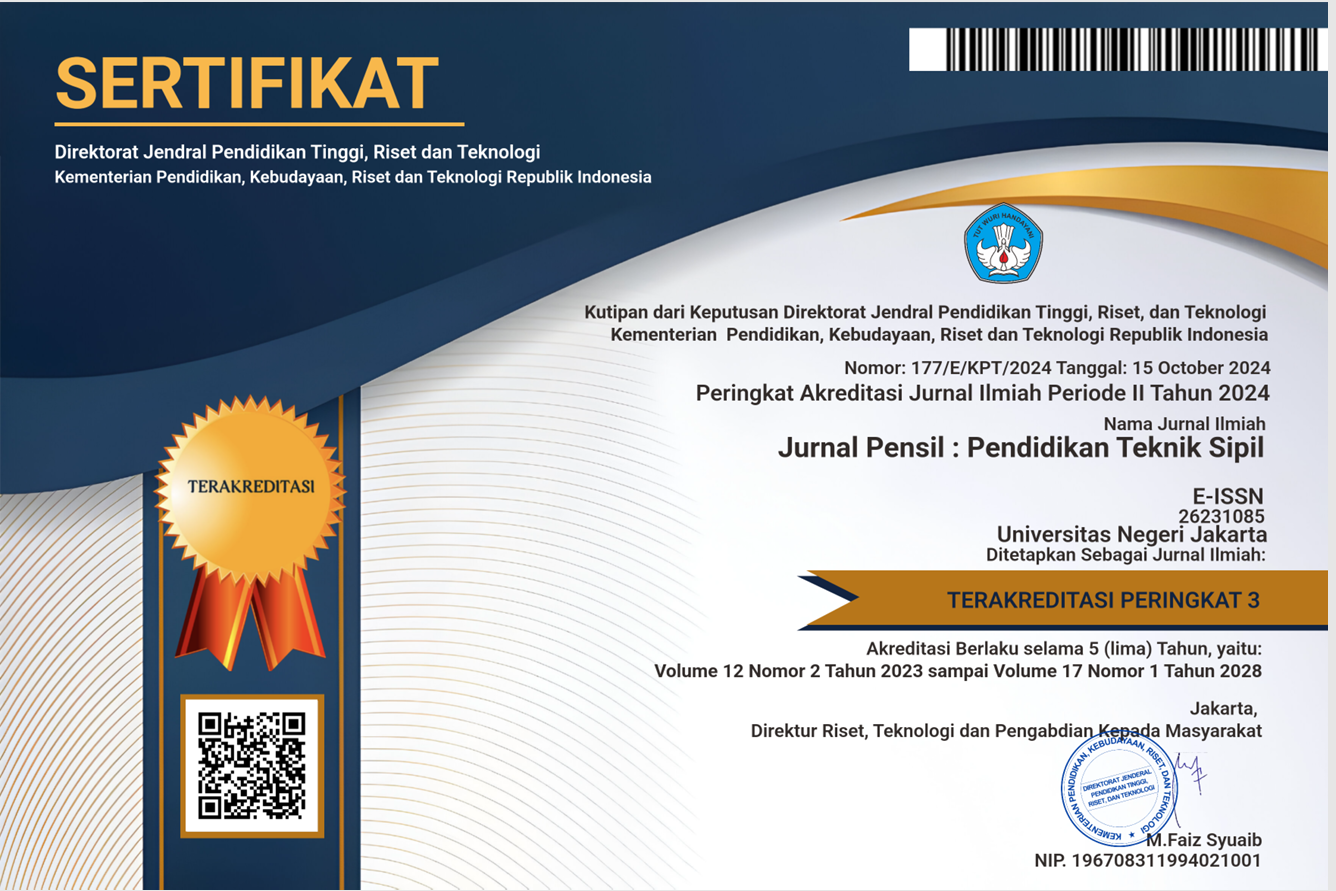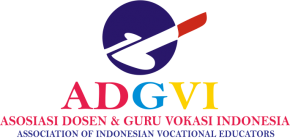EVALUTION OF LEARNING FACILITIES SUPPORTING CREATIVE PRODUCTS AND ENTREPRENEURSHIP IN MODELING DESIGN AND BUILDING INFORMATION EXPERTISE COMPETENCY
DOI:
https://doi.org/10.21009/jpensil.v12i1.31145Keywords:
Infrastructure, Learning Facilities, ComputerAbstract
This study aims to gain a general understanding of the state of educational infrastructure and learning facilities for creative and entrepreneurial products, as well as a general understanding of the degree of standard compliance and the appropriateness of the curriculum requirements for Vocational High School Modeling Design and Building Information Expertise Competency. This study employed a descriptive and methodology. An analysis of the infrastructure and learning environments for innovative and entrepreneurial products provides information on the degree of standard compliance. An overview of the condition of learning facilities and infrastructure for creative and entrepreneurial products obtains an illustration that the requirements for facilities and infrastructure for creative and entrepreneurial product learning in DPIB expertise competence are in the form of computer graphics, printers, projectors, computer desks, chairs, and Split AC. Computer graphics have a quantity proportion of 83.3% and a quality proportion of 33.3%, meaning that in terms of quantity it is sufficient but in terms of quality it needs to be improved. This causes the computer's ability to run software or applications, such as SketchUp and AutoCad, to be limited. Computer capabilities in the laboratory 1 & 2 can only install old software or output, such as AutoCad 2016 and SketchUp 2016, and unable installing rendering software. which will affect the level of suitability and the level of adequacy of the needs of the DPIB curriculum where the demand for vocational expertise competencies, especially DPIB expertise competencies which are closely related to graphics to realize superior global competitiveness.
References
Asnita, A., Armiati, A., & Cerya, E. (2019). ANALISIS PEMELIHARAAN SARANA DAN PRASARANA SEKOLAH DI SEKOLAH MENENGAH KEJURUAN (SMK) NEGERI 3 PADANG. Jurnal Ecogen, 1(4), 719. https://doi.org/10.24036/jmpe.v1i4.5649
Audu, R., Kamin, Y. B., & Balash, F. (2013). Technical Vocational Education: As a Veritable Tool for Eradicating Youth Unemployment. International Organization of Scientific Research Journal of Humanities and Social Science, 8(2), 10–17.
Aurigemma, J., & etal. (2013). Turning experiments objects: the cognitive processes involved in the design of a lab-on-achip device. Journal of Engineering Education, 102, 117–-140.
Devi, A. D. (2021). Standarisasi dan Konsep Sarana Prasarana Pendidikan. Edudikara: Jurnal Pendidikan Dan Pembelajaran, 6(2). https://doi.org/10.32585/edudikara.v6i2.242
Dharma, S., Sugiyono, Mulyatiningsih, E., Sutopo, Irwanto, Palunsu, jenny evelin, Triatmojo, P., & Siswanto, R. (2013). Tantangan Guru SMK Abad 21. In Direktorat Pembinaan Pendidik dan Tenaga Kependidikan Pendidikan Menengah.
Direktorat, S. (2020). Panduan Kualitas Sarana dan Prasarana SMK. Direktorat SMK Direktorat Jenderal Pendidikan Vokasi Kemendikbud.
Direktorat, S. (2021). Norma & Standar Laboratorium/Bengkel SMK Kompetensi Keahlian Desain Pemodelan & Informasi Bangunan. Direktorat SMK Direktorat Jenderal Pendidikan Vokasi Kemendikbud.
Diwangkoro, E., & Soenarto, S. (2020). Development of teaching factory learning models in vocational schools. Journal of Physics: Conference Series, 1456(1). https://doi.org/10.1088/1742-6596/1456/1/012046
Frisdila, F. (2020). Sarana Prasarana Pendidikan. Center for Open Science. https://doi.org/10.31227/osf.io/gd6qw
Ghufron, M. A. (2018). Revolusi industri 4.0: Tantangan, Peluang dan Solusi Bagi Dunia Pendidikan. Seminar Nasional Dan Diskusi Panel Multidisiplin Hasil Penelitian Dan Pengabdian Kepada Masyarakat, 332–337.
Herman, H., Suriani, L., & Farisha, N. (2021). Evaluasi Kebijakan Pengelolaan Sarana dan Prasarana Sampah Pada Pasar Milik Pemerintah Kota Pekanbaru. Publikauma : Jurnal Administrasi Publik Universitas Medan Area, 9(2), 81–90. https://doi.org/10.31289/publika.v9i2.6034
Hidayat, H., Herawati, S., Hidayati, A., & Syahmaidi, E. (2018). Pembelajaran kewirausahaan dengan pendekatan berbasis produksi sebagai alternatif mempersiapkan lulusan berkualitas di pendidikan tinggi. 123–129.
Kemendikbud. (2018). Kemendikbud Dorong SMK Ciptakan Wirausaha Muda.
Peraturan Menteri Pendidikan Nasional No. 40 Tahun 2008 Tentang Standar Sarana Dan Pra-sarana Sekolah Menengah Kejuruan/ Madrasah Aliyah Kejuruan (SMK/ MAK, (2008).
Klotz, V. K., Winther, E., & Festner, D. (2015). Modeling the Development of Vocational Competence: a Psychometric Model for Economic Domains. Vocations and Learning, 8(3), 247–268. https://doi.org/10.1007/s12186-015-9139-y
Mar, V. (2011). Introducing UNESCO’s Technical Vocational Education and Training (TVET) Definition and Strategy. UNESCO.
Murtinugraha, R. E., Ramadhan, M. A., & Andarista, P. L. (2021). KESESUAIAN STANDAR SARANA PRASARANA SMK KOMPETENSI KEAHLIAN DESAIN PEMODELAN DAN INFORMASI BANGUNAN (Studi pada SMKN 56 Jakarta dan SMKN 35 Jakarta). Jurnal Pendidikan Teknik Sipil, 3(1), 1–10. https://doi.org/10.21831/jpts.v3i1.41881
Nurdina, H., Martono, T., & Sangka, K. B. (2019). TANTANGAN DAN PELUANG SEKOLAH MENENGAH KEJURUAN MELALUI PENDIDIKAN KEWIRAUSAHAAN DALAM MENGHADAPI ERA DIGITAL. 3.
Pardjono, P., Suyanto, W., Sofyan, H., & Wagiran, W. (2018). What do Vocational Teachers, Industries, and Experts View about the Future Learning of Vocational Schools? Advances in Social Science, Education and Humanities Research (ASSEHR), 201(Aptekindo), 250–255.
Pavlova, M. (2009). Technology and vocational education for sustainable development. Spinger.
Peraturan Presiden Nomor: 6 Tahun 2009 tentang Ekonomi Kreatif, (2009).
PH, S. (2013). PENGEMBANGAN SMK MODEL UNTUK MASA DEPAN. Jurnal Cakrawala Pendidikan, 14–26.
Prihadi, W. R., Malik, A., & Suparman, S. (2021). Implementasi Pembelajaran Kewirausahaan SMK Bidang Keahlian Teknologi Konstruksi dan Properti di Yogyakarta. Jurnal Pensil: Pendidikan Teknik Sipil, 10(1), 21–33.
R, A., Kamin, Y. Bin, & Saud, M. S. Bin. (2013). Acquisition of Employability Skills in Technical Vocational Education; Necessity For The 21st Century Workforce. Aust J Basic and Applied Sci, 7(6), 9–14.
Rachmad Prihadi, W. (2019). Model Teacherpreneur Pada Pembelajaran Vokasi Menghadapi Era Disrupsi Dan Revolusi Industri 4.0. Jurnal Pendidikan Teknik Sipil, 1(1). https://doi.org/10.21831/jpts.v1i1.28274
Ramdhiani, R., & Rahminawati, N. (2021). Analisis Pengelolaan Sarana dan Prasarana Pembelajaran. Jurnal Riset Pendidikan Guru Paud, 1(2), 95–101. https://doi.org/10.29313/jrpgp.v1i2.389
Sanjaya, W. (2008). Kurikulum dan pembelajaran: teori dan praktek pengembangan Kurikulum Tingkat Satuan Pendidikan (KTSP). Kencana.
Setiadi, & P.H. (2008). Pengaruh sarana dan prasarana belajar tehadap hasil belajar mata pelajaran alat ukur. Jurnal Pendidikan Teknik Mesin, 8(mor 2), 83– 86.
Sirait, R. M. (2021). EVALUASI STANDAR KELAYAKAN SARANA DAN PRASARANA RUANG PRAKTIK PADA PROGAM KEAHLIAN TEKNIK GAMBAR BANGUNAN SMK N 5 MEDAN. Jurnal Ilmiah Pendidikan Teknik Dan Kejuruan, 14(2), 108. https://doi.org/10.20961/jiptek.v14i2.38122
Snyder, J. F., & Hales, J. A. (1976). Trailblazing to 2016 in shop planning. Dalam Modern School Shop Planning (seventh). Praken Publication, Inc.
Storm, G. (1983). Managing the Occupational Education Laboratory. Prakken Publication Inc.
Sudira, P. (2017). TVET Abad XXI Filosofi, Teori, Konsep, dan Strategi Pembelajaran Vokasional. UNY Press.
Sudira, P. (2019). The Role of Vocational Education in the Era of Industrial Automation. Journal of Physics: Conference Series, 1273(1). https://doi.org/10.1088/1742-6596/1273/1/012058
Sudiyono, S., & Alip, M. (2016). Evaluasi Sarana Dan Prasarana Bengkel Praktik Smk Teknik Pemesinan Di Kota Semarang Berdasarkan Kebutuhan Kurikulum. Jurnal Pendidikan Vokasi, 6(1), 79. https://doi.org/10.21831/jpv.v6i1.8117
Sudrajat, A. (2018). Sekolah Kejuruan, Antara Permintaan dan Kompetensi Lulusan.
Surono, S., & Wagiran, W. (2016). Profil Guru Smk Teknik Pemesinan Dan Relevansinya Dengan Kurikulum Prodi Pendidikan Teknik Mesin Ft Uny. Jurnal Pendidikan Vokasi, 6(1), 94. https://doi.org/10.21831/jpv.v6i1.8128
Usiono, U., Amin, A., & Damanik, S. (2021). Perencanaan Sarana dan Prasarana Pendidikan di SMK Negeri 1 Percut Sei Tuan. Edumaspul: Jurnal Pendidikan, 5(2), 124–132. https://doi.org/10.33487/edumaspul.v5i2.2055
Wijayanti, M., & Jaedun, A. (2019). Relevansi Kompetensi Lulusan Kejuruan Teknik Bangunanuntuk Bekerja Di Industri Konstruksi. Jurnal Kependidikan, 3(1), 81–94.
Winarno, A. (2015). Pendidikan Kewirausahaan SMK dengan K-13: Perspektif Guru dan Sekolah. Prosiding: Seminar Nasional Ekonomi Manajemen dan Akuntansi (SNEMA), Fakultas Ekonomi Universitas Negeri Padang.
Downloads
Published
How to Cite
Issue
Section
License
Copyright (c) 2023 wisnu rachmad

This work is licensed under a Creative Commons Attribution-ShareAlike 4.0 International License.











.png)
.png)
1.png)

